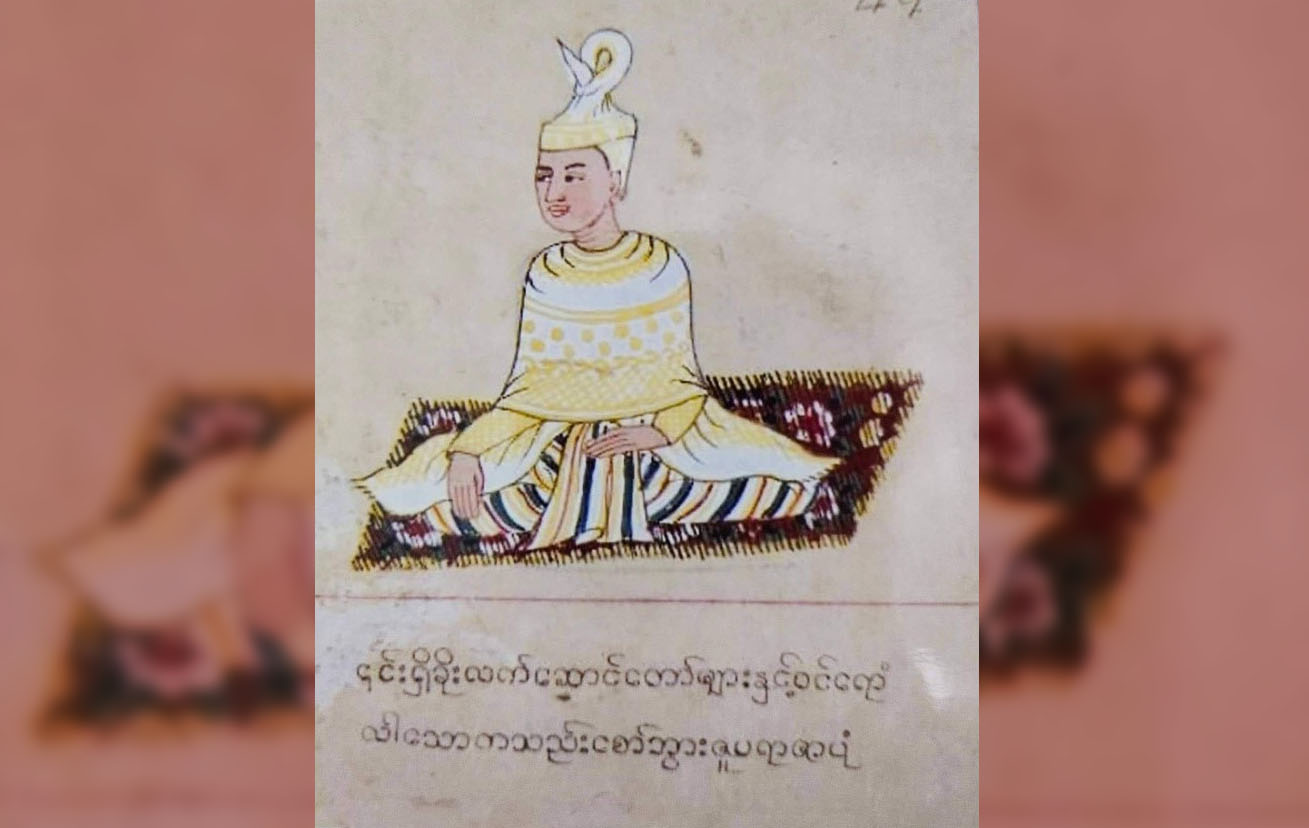“I am satisfied with the success of this exhibition, which drew more than one thousand visitors, many of whom were previously unaware of the indigenous traditional Subika paintings of Manipur. These visitors, lacking prior knowledge of this art form, not only experienced the exhibition but also shared their newfound appreciation with others. This dissemination of knowledge will help raise awareness about this school of Art, which has been on the brink of extinction.”
- Yumnam Sapha Wangam Apanthoi M
As I stepped into the cosy Book and Coffee store in Imphal, I was transported to a realm of wonder and awe. The “Manipuri Mythology and Folklore” art exhibition, showcasing modern Subika Art by the renowned artist Dr Sapha Yumnam, was a treasure trove of creativity and cultural heritage. This enchanting exhibition was a culmination of the artist’s dedication to reviving the Indigenous traditional Subika paintings, which are on the brink of extinction.
The exhibition, presented in collaboration with Imasi Foundation, Puffin Books, Penguin Books, and Penguin Audio, kicked off with a vibrant display. Featuring 36 paintings commissioned by Penguin for “And That is Why: Manipuri Myths Retold (2021)” by L. Somi Roy and Thangjam Hindustani, it also marked the release of “Feathers, Fools and Farts: Manipuri Folktales Retold” and its accompanying audiobook on its opening day in Imphal. Open until July 17th, I made sure to attend on its final day, knowing I’d regret missing out.
A Glimpse from the Exhibition
Showcasing the revival of a centuries-old art form, the exhibition features Dr. Yumnam Sapha’s remarkable re-interpretation of Subika paintings, a style on the verge of extinction. A prominent artist and academician from Manipur University’s Department of Fine Art, Dr. Sapha has dedicated himself to preserving the traditional Subika art of Manipur. His works are inspired by the intricate illustrations found in Subika manuscripts, ancient Manipuri manuscripts known as Puya, which are the only manuscripts of their kind to feature illustrations. The Subika painting style is deeply rooted in the cultural heritage of the Meitei community, yet despite its historical significance, it has faced neglect in recent years, leading to a decline in awareness. Through his art, Dr. Sapha aims to revive and honour this traditional style, ensuring its beauty and cultural importance are appreciated by new generations. His creations are not mere replicas but a thoughtful re-creation of the Subika art form, imbued with modern sensibilities.
As I stepped into the exhibition hall, I initially felt a sense of congestion due to the limited space. However, my concern was quickly alleviated as I noticed the thoughtful display of artworks. Despite the small size of the hall, the artworks were tastefully displayed, grouped in clusters that corresponded well with the stories they portrayed. The intimate scale of the artworks and the careful curation allowed me to comfortably navigate the space alongside other viewers, creating a sense of communal discovery and appreciation.
Viewers are allowed to thoroughly enjoy the exhibition as each painting evoked memories of the diverse folk tales and mythologies we had heard during our childhood. Everyone constructs their own interpretations and visualizations of these stories, shaped by their imagination and personal experiences. Viewing the paintings in this exhibition offered the spectators a fresh perspective, different from our previous assumptions. Previously, almost everyone had imagined these stories in relation to the familiar aspects of the real world. However, the exhibition’s depiction of Manipuri mythology and folktales introduced us to a unique realm of fantasy. The artworks spoke a distinct visual language, sparking a sense of wonder and delight that I had never encountered before.
Upon closer inspection, the paintings in the exhibition appeared to be more decorative and schematic compared to traditional Subika paintings. The artist’s innovative use of modern techniques and styles added a fresh twist to the indigenous art form. For instance, the incorporation of background colours, subtle tone gradations, and deliberate dot placement created a sense of depth and movement. The strategic use of colour palettes, such as green for vegetation, while greyish-white circles denote moonlit scenes and reddish orbs suggest daytime settings. These choices enrich the visual narrative, introducing a dynamic play of light and atmosphere that diverges from the original Subika tradition. Additionally, the artist’s decision to depict multiple scenes from the same story within a single frame showcased his creative storytelling approach which not only enhances narrative complexity but also invites viewers to explore layers of meaning and continuity across the artworks. These modern adaptations breathed new life into the traditional Subika style, making the artwork feel both contemporary and timeless.
When visitors enter the exhibition hall, everyone is greeted by an informative abstract that serves as a gateway into the artistic realm of Subika paintings and the exhibition itself. This introductory piece serves as a threshold to the artistic world within, inviting viewers to engage with the exhibition on a deeper level. It sets the stage by elucidating the essence of Subika paintings, offering context that enriches the understanding and appreciation of the artworks on display. In doing so, the abstract not only informs but also ignites curiosity, encouraging visitors to explore and interpret the exhibited pieces through a deeper lens of cultural and artistic significance.
During the conversation with the artist, he expressed his satisfaction with the success of his exhibition, highlighting that more than one thousand visitors, previously unaware of the indigenous traditional Subika paintings of Manipur, attended the event. The artist emphasized that these visitors, many of whom had no prior knowledge of this art form, not only experienced the exhibition but also shared their newfound appreciation with others and this dissemination of knowledge will help raise awareness about this unique school of manuscript painting of Manipur, which has been on the brink of extinction.
Such a positive and innovative approach reflects the artist’s distinctive mindset, which has undoubtedly contributed to his recognition as a distinguished contemporary artist. His ability to engage and educate the public about a nearly extinct art form demonstrates his commitment to preserving cultural heritage while fostering a deeper understanding and appreciation of Indigenous traditional arts.
During my visit to the exhibition, an interesting question came to mind: does the text promote this visual art form, or does the visual art form promote the text? In my view, both text and images promote each other. The use of modern re-interpretation of Indigenous traditional Subika paintings to illustrate the mythology and folklore of Manipur is a brilliant initiative, showcasing the interdependent relationship between literary and visual art. This harmonious fusion not only enriches our understanding of the text but also breathes new life into the traditional art form.
The “Manipuri Mythology and Folklore” exhibition at the Book and Coffee store in Imphal was a profound experience, spotlighting the revival of the Indigenous Subika paintings through the modern lens of Dr. Sapha Yumnam. Collaborating with Imasi Foundation and Penguin Books, the exhibition drew nearly a thousand visitors, many of whom were introduced to this nearly extinct art form for the first time. Dr. Sapha’s innovative approach to illustrating the Books “And That is Why: Manipuri Myths Retold (2021)” and “Feathers, Fools and Farts: Manipuri Folktales Retold (2024)” highlighted the interdependent relationship between text and visual art, demonstrating how each can enhance and enrich the other. His dedication to preserving and honouring the cultural heritage of the Meitei community while fostering a deeper appreciation for the traditional Subika style has solidified his reputation as a distinguished contemporary artist. This exhibition not only celebrated the beauty and significance of Subika paintings but also ensured their legacy would be appreciated by future generations.












